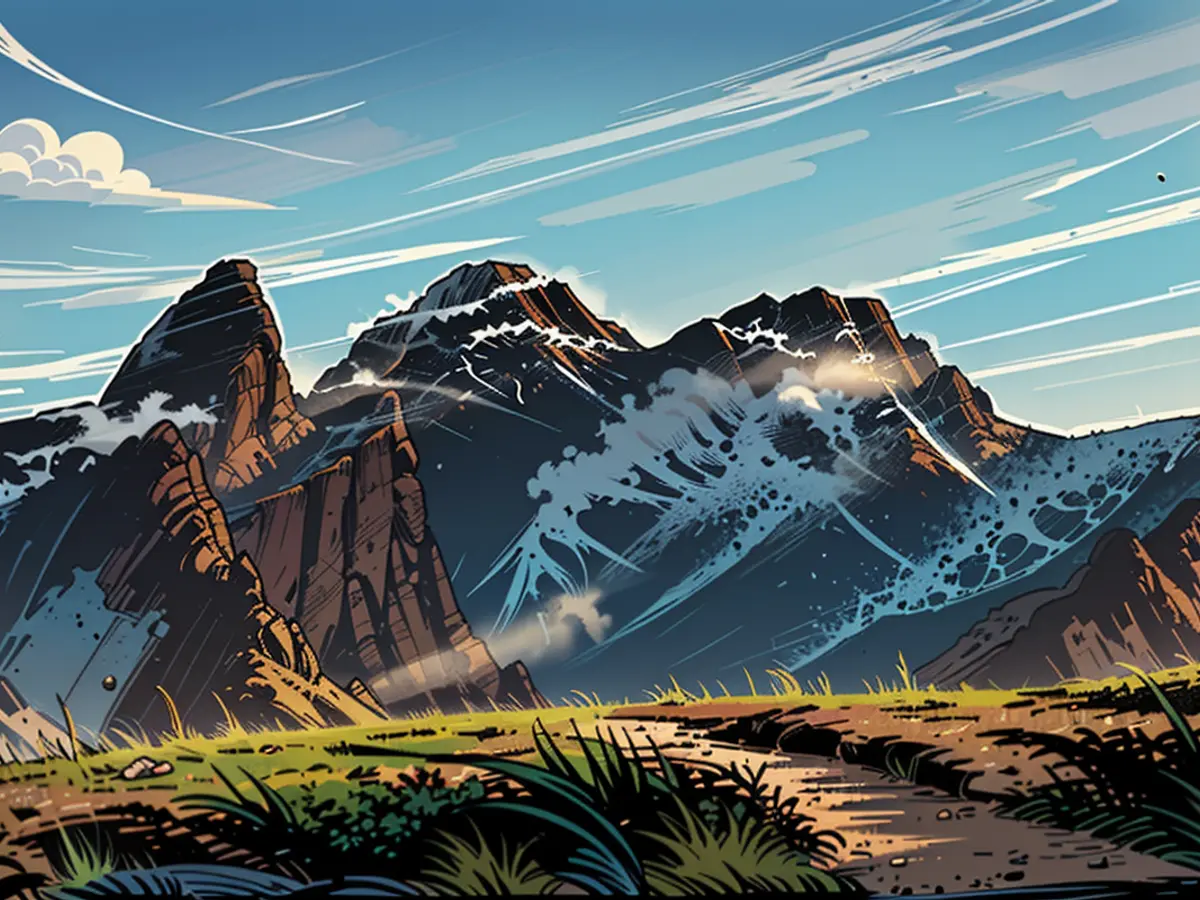Heat, heavy rain and thunder - Extreme weather increases risks in the mountains
Changing extreme weather conditions in the mountains bring specific dangers. Heavy rain poses a risk of rockslides and mudslides, and heat waves above 30 degrees lead to numerous issues for hikers due to dehydration, according to Stefan Winter from the German Alpine Club (DAV).
In the Mediterranean region, several people have already died from heat-related incidents during hikes. Media reported a series of fatalities on Greek holiday islands in June. Many hikers likely succumbed to the heat, some of them carrying insufficient water and becoming disoriented or exhausted. This danger is not limited to the Mediterranean area, Winter warned. In our country, the weather is sometimes underestimated, especially when temperatures fluctuate significantly from day to day as they have in recent weeks.
"Due to the atmospheric conditions, a stable summer high has not yet formed. We have had very changeable weather conditions with a lot of rain. This makes tour planning difficult." Many people are not prepared for a sudden change from cool rainy weather to intense heat. "The quick transition from cool rainy weather to heat can overtax people's assessment. They only see: nice weather - let's go out."
Hikers should not underestimate heat and fatigue
Most accidents, according to the DAV's mountain accident statistics, which are published every two years, occur during hiking - often during descent, when hikers are tired. The risk of tripping is also greater then. In the summer season, heart-circulatory problems, often related to heat, rank second.
During rain, the risk of slipping on slippery surfaces arises, explained Winter. Additionally, there is a risk of drowning, hypothermia, and exhaustion. Mountain streams can swell rapidly and sweep people away - or wash away trails, making return routes impassable or turning simple hikes into challenges.
Another danger, especially on exposed trails and on climbing routes with a lot of ironwork, are thunderstorms with lightning strikes. Where exactly they will discharge, however, is not predictable according to Winter.
Avalanches and snow can be a problem
In high-altitude areas in Austria, France, Italy, and Switzerland, there is a growing risk of avalanches due to rising temperatures on glaciers. In 2022, large parts of the Marmolata glacier in Trentino broke off and killed eleven mountain climbers.
Currently, however, there is still a lot of snow in the high-altitude regions, which has not yet frozen. "In certain regions, this is still an issue. Some of the classic glacier tours in Valais and Bernese Oberland have not yet been explored, as there is still so much snow," said Winter. In April and May, there was still a lot of snow at high altitudes.
In the Bavarian mountains, snow fields are no longer a significant issue, according to Winter. The Watzmann Overstep above 2500 meters is snow-free. "Only during descent is there still a little snow," said Winter. Above 2000 meters, there are still some small snowfields - in the mountains not unusual. "People still slip on snowfields in August and September. The greatest snowfield problem in the Bavarian Alps is in April."
So far, the summer here has not shown itself as extreme as last year with various heat records. However, the DAV has concerns that huts may have to close again due to water shortages - like the Neue Prager Hütte in Tauer in Austria last year.
- Despite the changing Climate, Garmisch-Partenkirchen in the Alps continues to attract Tourists, offering leisure activities despite the weather uncertainties.
- The German Alpine Club (DAV) advises hikers to beware of rain showers, as they increase the risk of slipping on slippery surfaces and potentially lead to drowning, hypothermia, and exhaustion.
- During a recent rain shower in Garmisch-Partenkirchen, several hikers had to be rescued due to sudden thunderstorms and lightning strikes, highlighting the unpredictability of mountain weather.
- In Austria, a group of hikers unfortunately encountered an accident during a rain shower, with heavy rain making the terrain slippery and difficult to navigate.
- The Bavarian Alpine Club, a branch of the German Alpine Club, is urging hikers to be prepared for sudden changes in weather, especially during the transition from cool rainy weather to intense heat.
- Last year, a group of mountain climbers in Austria suffered an accident due to avalanches caused by rising temperatures on glaciers, emphasizing the importance of being aware of the weather conditions in the Alpine region.
- The German Alpine Club is collaborating with authorities in Austria, Germany, and neighboring countries to monitor weather patterns and warn hikers of potential dangers, aiming to minimize the number of accidents due to extreme weather conditions.
- While the current summer in Garmisch-Partenkirchen is not as extreme as the previous year, the German Alpine Club is still urging hikers to be cautious and prepare for any weather situation, reminding them that mountains are unpredictable and Mother Nature can change at a moment's notice.








